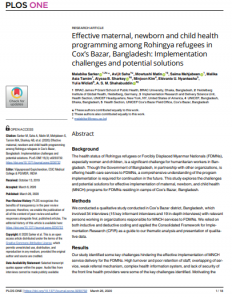
Background
The health status of Rohingya refugees or Forcibly Displaced Myanmar Nationals (FDMNs), especially women and children, is a significant challenge for humanitarian workers in Bangladesh. Though the Government of Bangladesh, in partnership with other organizations, is offering health care services to FDMNs, a comprehensive understanding of the program implementation is required for continuation in the future. This study explores the challenges and potential solutions for effective implementation of maternal, newborn, and child health (MNCH) programs for FDMNs residing in camps of Cox’s Bazar, Bangladesh.
Methods
We conducted a qualitative study conducted in Cox’s Bazar district, Bangladesh, which involved 34 interviews (15 key informant interviews and 19 in-depth interviews) with relevant persons working in organizations responsible for MNCH services to FDMNs. We relied on both inductive and deductive coding and applied the Consolidated Framework for Implementation Research (CFIR) as a guide to our thematic analysis and presentation of qualitative data.
Results
Our study identified some key challenges hindering the effective implementation of MNCH service delivery for the FDMNs. High turnover and poor retention of staff, overlapping of service, weak referral mechanism, complex health information system, and lack of security of the front line health providers were some of the key challenges identified. Motivating the health workers, task shifting, capacity building on emergency obstetric care, training CHW & TBA on danger signs, and ensuring the security of the workers are the potential solutions suggested by the respondents. Selecting a few indicators and the introduction of E-tracker can harmonize the health information system.
Conclusion
Providing healthcare in an emergency setting has several associated challenges. Considering the CFIR as the base for identifying different challenges and their potential solutions at a different level of the program can prove to be an excellent asset for the program implementers in designing their plans. Two additional domains, context, and security should be included in the CFIR framework for any humanitarian settings.